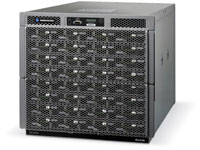This is an interesting turn of events.
Lately, startups like Calxeda and SeaMicro have been making waves by enticing data center operators with the promise of potent yet power-sipping servers using low-watt processors that are decidedly non-standard on servers. Namely, ARM- and Intel Atom-based chips, respectively.
Now it turns out that SeaMicro sees some value, or at least expanded market opportunities, in that old server stand-by, the Xeon. Hence the SM10000-XE, a server containing 64, quad-core Sandy Bridge-based Xeons at 2.4 GHz.
The point, according to this HPCwire piece, is to make quick work of mainstream enterprise workloads.
With the addition of low-wattage but more performant Xeons into the mix, SeaMicro is looking to expand the microserver business into what it calls “brawny applications.” That includes more traditional enterprise workloads like Java, PHP, MemCacheD, and NoSQL, as well as web-based database processing. SeaMicro CEO Andrew Feldman characterized the new Xeon-powered SM10000-XE as the “the mainstreaming of the microserver.”
And keeping with the company’s energy- and space-saving roots, the server takes up a third of the space and uses half the power — 3.5 KW on average — of a comparable system comprised of volume rack servers, according to SeaMicro.
All good stuff, but what does it mean for the company’s Atom-based hardware? While SeaMicro’s CEO, Andrew Feldman, expects bigger sales from its Xeon hardware, the tech that put it on the map is doing alright…
Even without the SM10000-XE though, the company has been doing “phenomenal,” according to Feldman. Although he didn’t offer how much revenue his company collected during their first year of business (2011), Feldman says it was more than the combined sales of Riverbed, 3PAR, Aruba Networks and Data Domain combined during their first year. “It looks pretty bright out there right now,” he says.
A little vague, but good to know.


Leave a Reply